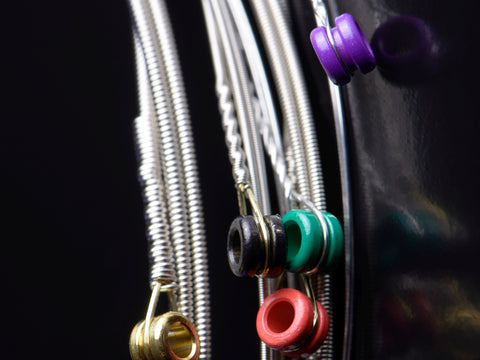Even if you’ve only been playing guitar for a short while, you know that good action and a proper setup is everything. In fact a good setup is nearly as important as the guitar brand when it comes to playability. So imagine the horror of changing strings one day and finding out your setup, action, & playability is now totally different! This has happened to many a guitarist, especially with the variety of strings now available.

Did you know certain new guitar strings, even strings of the same size and gauge, can totally alter and wreck a good expensive setup? It’s true, read on to learn why and how not to be caught off-guard.
“Setup” in the guitar world refers to how the guitar strings, their gauge, string height, and intonation are set properly at the factory or by a knowledgeable tech. “Action” refers to the tiny distance untouched strings float above the frets. String "gauge" is the thickness of the strings, as guitar strings come in varying gauges such as light, custom light, medium, etc. all based on preference.
In this article we'll outline important setup steps and their order. And we’ll point out how certain strings can change a setup even if everything else is done right. If you are familiar with the individual steps and techniques, then this article will be a quick checklist and “order of operations” in which they should be done. If someone else is doing the work, this is a good excuse to make sure they are doing all the steps outlined after you’ve selected strings.
So here’s the quick checklist for what you need to know in attaining the correct setup! The order is important so these are steps to follow:
1) Select the gauge and type of guitar strings you like.
If you like what you’re playing and don’t feel like switching, this is the first step to being on your way to a good guitar setup. This is because putting a different gauge or brand of strings on your acoustic or electric guitar can sometimes affect various aspects of your guitar’s setup. More on that later. For now, just realize if you have settled on a particular brand and gauge and aren’t going to be changing anytime soon, that’s good! (Also, you never have to worry about losing your setup if you are replacing strings with the exact same brand and gauge. If you like "GHS Boomers" in 9-42, putting a fresh identical pack on won't change your setup.) If it ain’t broke, why fix it, right? That's why it's so important to settle on strings first. Because a change could require an entire setup again.  Lately there have been some new guitar string alloys that have come available, some boast extra “bendable” attributes. Please note some of these strings can greatly change your guitar’s action because of the different tension they present. This even happens with strings that are the exact same gauge but a different alloy! Also many guitarists have changed brands or bought the sale item strings of the same gauge, not knowing that in certain cases it whacked out their guitar. This is why it’s important to settle on the kind of strings you like before doing a setup, otherwise expect to possibly pay for a whole new setup. If you are going to experiment with new kinds of strings, and there is nothing wrong with doing so, the worse thing you can do is buy a 10-pack because it was on sale! Buy one set first to see how it acts and if you like it before jumping in ten-deep.
Lately there have been some new guitar string alloys that have come available, some boast extra “bendable” attributes. Please note some of these strings can greatly change your guitar’s action because of the different tension they present. This even happens with strings that are the exact same gauge but a different alloy! Also many guitarists have changed brands or bought the sale item strings of the same gauge, not knowing that in certain cases it whacked out their guitar. This is why it’s important to settle on the kind of strings you like before doing a setup, otherwise expect to possibly pay for a whole new setup. If you are going to experiment with new kinds of strings, and there is nothing wrong with doing so, the worse thing you can do is buy a 10-pack because it was on sale! Buy one set first to see how it acts and if you like it before jumping in ten-deep.
2) Be sure your neck is adjusted before modifying anything else.
Some people like to dive straight into guitar action, lowering a bridge or even shaving down a saddle on an acoustic guitar, without properly adjusting the neck. This is like buying brand new tires because yours wore out too soon, and never checking to see if the car needed an alignment first. There are people on YouTube talking about adjusting string action with no mention of a proper neck-check first. This is a flawed approach and it’s important to adjust the neck first. Why is this? Because even if you adjust or lower the action at the bridge, the neck still needs to be addressed via the truss rod adjuster. If you adjust the neck before doing anything else, often a bowed neck has higher action and by adjusting the bow out, you solve two issues at once. This means neck adjustments often create a nice side affect of a little lower action. As a neck bow is removed, the strings automatically come as much as a millimeter or two closer to the fretboard as the neck straightens. Some guitars ONLY need a neck adjustment, which means skipping action and messing with the bridge. See step 3 below for our video on neck and action.
3) Buzz-free zone: Adjust action at the saddle or bridge.
With the neck correctly adjusted you can now check the action. String action height is subjective, there are those that like higher action. There are others that need it higher especially if they play and strum hard. But most guitarists want the lowest action possible that doesn’t create buzzing. The only way to achieve this is to make sure you’ve settled on your favorite kind of guitar strings and your neck is straight as mentioned in steps #1-2. Now you can check and adjust action which is either done by tiny screws for each individual string saddle, or with two bolts that raise and lower bridge height. The two bolt type is by far the most common, such as on Gibson Les Paul and most guitars with a Floyd Rose style whammy bar. Action adjustment is a skill and definitely a separate how-to article, but a brief summary is to lower string height a very small amount at a time, then tune the strings back to pitch and play the guitar. If no string buzzing occurs and the action still seems higher than you’d like, then continue to lower the action until the correct balance of action and no-buzz is achieved. Important – some players accept a small buzz in exchange for super low action. On an electric guitar, you can get away with a little fret-buzz because in almost all cases a little string buzz is not captured by the guitar pickups! (There is one kind of buzz that is A-OK, and he's pictured here): 
On an acoustic or classical guitar, action adjusting is done by removing the white saddle from the bridge. It is then machined or cut down in height. Once again this is a skill so refer to the appropriate source or technician. It is also not really reversible like on an electric; reversing requires buying a new saddle and having it re-crafted. We have a separate article and video on this topic here: Lower Action the Right Way Blog
4) Floyd Rose and other tremolo systems require more attention.
If your guitar has any kind of whammy bar or tremolo system, Floyd Rose, Kahler, Hardtail-style, PRS, please realize it greatly affects the setup. The tremolo base should rest straight and flush with the guitar body before adjusting action. Sometimes changing string gauges means the tremolo springs (springs not strings!) inside the back of the guitar need to be accessed. Telltale signs are your tremolo bridge leans terribly forward after a string change. This can occur by putting heavier gauge strings on your guitar. Or if the bridge has moved quite a bit backward, just like if you pulled UP on the bar, this is a sign your new guitar strings are either much lighter gauge or a different kind of alloy that is exerting less pressure on your bridge. In either case, the change in tension from the strings is compensated by movement of the tremolo springs, and your whammy tremolo base moves like a see-saw. Usually a simple Philips screwdriver adjustment remedies the problem, but again this is a bit of an art and requires some technical experience.
So there you have it, the proper "order of operations" needed in assessing your setup, and a friendly warning that a simple change in guitar strings to a new kind can totally annihilate an expensive guitar setup. There is nothing that makes your guitar play better than a proper setup, so if you’ve recently had your guitar setup, why wreck it with a hasty string change? There is also nothing wrong with trying new strings and new styles! Just know it can affect a setup, ask a sales person if any of the house guitars already have these strings for you to try, or maybe try a set on your “second” guitar to see how it affects the setup? Knowing these points ahead of time can eliminate much frustration! Jason
-------------------
Speaking of frustration, eliminate scratches and light surface blemishes for good with the Player’s kit Guitar Scratch Remover… click below for more info! Any questions about this article feel free to get in touch with us!

